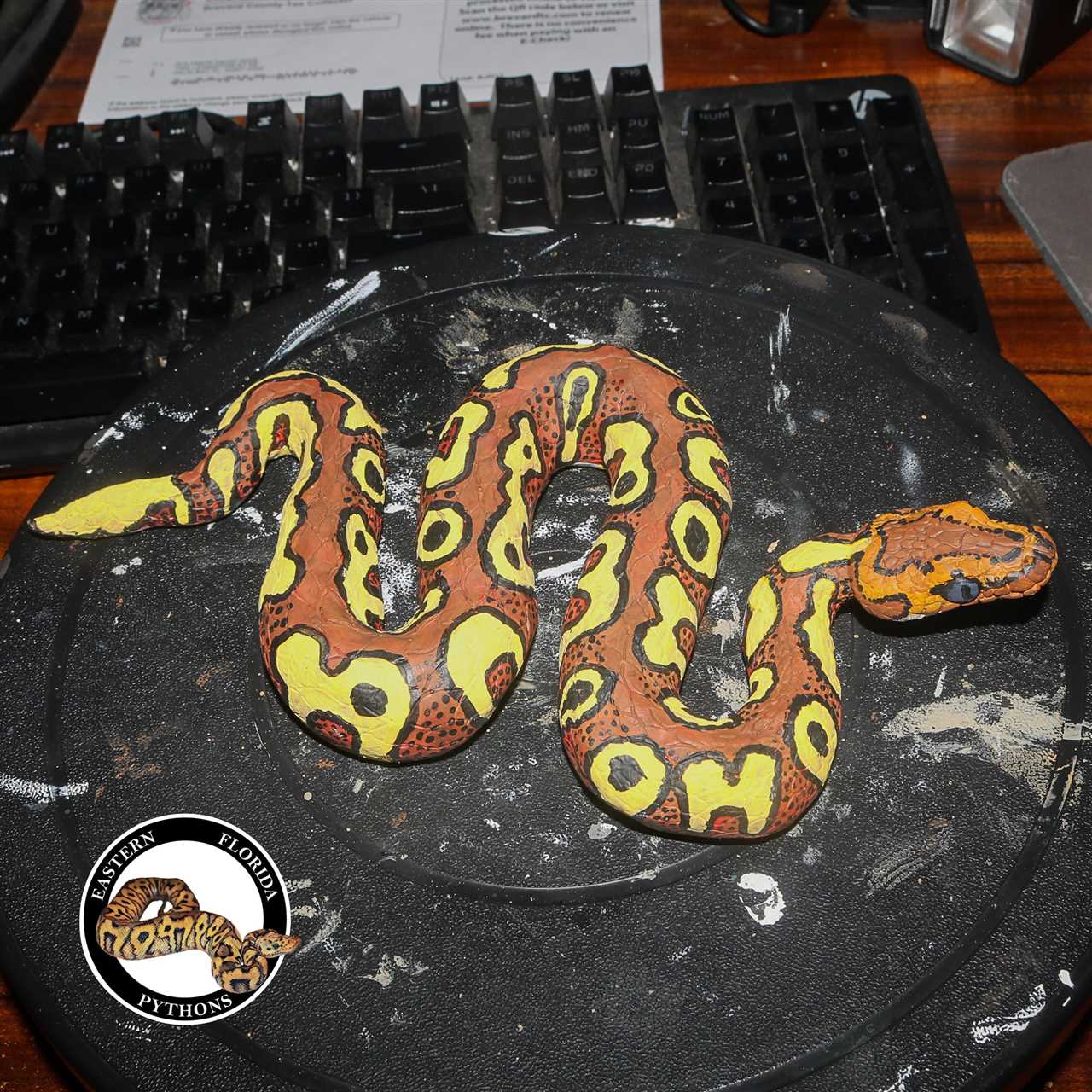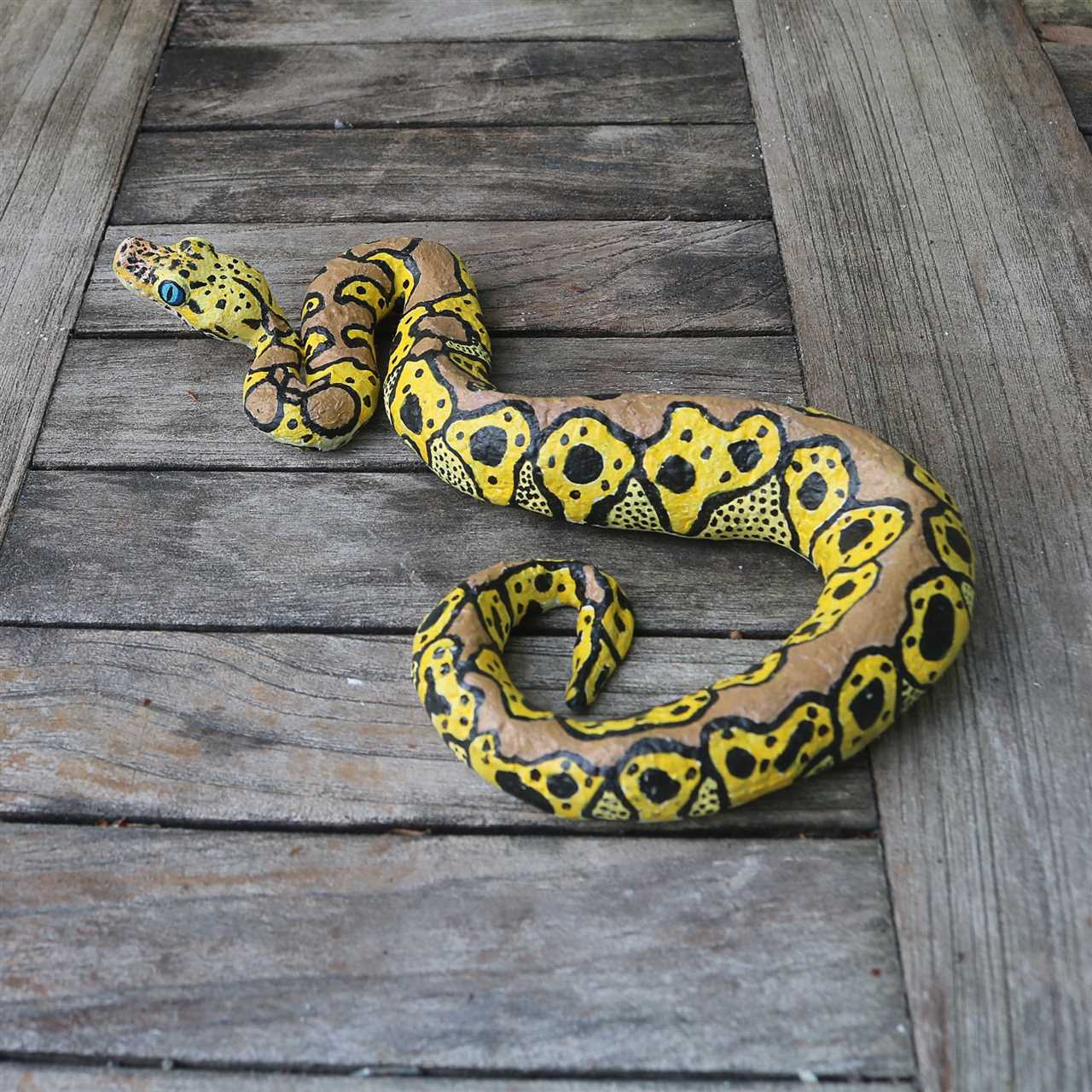The Pompeii Ball Python is an awe-inspiring reptile known for its mesmerizing pattern and vibrant colors. This morph of the ball python species has captured the attention of snake enthusiasts worldwide, and it’s easy to see why. With its striking combination of black, gold, and red markings, the Pompeii ball python stands out amongst other snake breeds.
Named after the ancient Roman city, this breed pays homage to the historic disaster that unfolded in Pompeii. Just like the city’s destruction, the Pompeii ball python’s pattern is a testament to the power and beauty found in nature. The intricate design on its scales creates a stunning visual effect, making it a highly sought-after breed in the snake breeding community.
The Origin of the Pompeii Ball Python
The Pompeii Ball Python is a unique and striking morph of the ball python, a popular snake breed commonly kept as pets. This particular morph is known for its mesmerizing coloration and beautiful pattern, which sets it apart from other ball pythons.
The Pompeii Morph
The Pompeii morph is the result of selective breeding of ball pythons with specific genetic traits. Breeders have carefully selected and bred snakes with unique color patterns to create the Pompeii morph.
The most distinctive feature of the Pompeii Ball Python is its pattern, which resembles the ancient city of Pompeii. The pattern consists of dark, smoky patches mixed with lighter areas, giving it an almost volcanic appearance. This unique color and pattern combination make the Pompeii Ball Python highly sought after by reptile enthusiasts and collectors.
Breeding the Pompeii Ball Python
The breeding process for the Pompeii Ball Python involves pairing two snakes with the desired genetic traits. Breeders will select parent snakes that display the characteristic Pompeii pattern and breed them together to produce offspring with the same pattern.
Due to the high demand for this morph, breeding the Pompeii Ball Python can be a profitable venture for experienced breeders. However, it is crucial to prioritize the health and well-being of the snakes throughout the breeding process.
The Pompeii Ball Python is a mesmerizing morph of the ball python, a popular and fascinating reptile species. What sets the Pompeii apart is its striking color pattern, which is unlike any other ball python.
The colors of the Pompeii Ball Python are reminiscent of Pompeii, the ancient Roman city that was preserved and rediscovered centuries later. The snake’s scales are a beautiful combination of deep blacks, rich browns, and vibrant oranges, creating a truly unique and eye-catching appearance.
The pattern on the Pompeii Ball Python can vary from one individual to another, making each snake even more special. Some have intricate patterns that resemble the ancient ruins of Pompeii, while others have more symmetrical geometric designs. No two Pompeii Ball Pythons are exactly alike.
Breeders find the Pompeii Ball Python highly desirable due to its distinct pattern. The unique coloration and markings make it an excellent choice for those looking to add something extraordinary to their reptile collection.
Breeding the Pompeii Ball Python
Producing a Pompeii Ball Python involves carefully selecting and pairing individuals with desirable patterns and colors. Breeders seek to refine and enhance the unique characteristics of this mesmerizing morph.
Once the breeding pair is selected, the female will lay a clutch of eggs, which will incubate for about 55-60 days. The breeder must monitor the temperature and humidity to ensure the eggs develop properly. Finally, the eggs will hatch, revealing the next generation of Pompeii Ball Pythons.
Caring for Your Pompeii Ball Python
Housing and Environment
The first step in caring for your Pompeii Ball Python is to provide them with a suitable habitat. The enclosure should be spacious enough for the snake to move around comfortably, with a secure lid to prevent escapes. A glass tank or plastic tub with proper ventilation works well for this purpose.
Ensure that the enclosure has plenty of hiding spots and branches for your snake to climb on. This will provide them with a sense of security and mimic their natural habitat.
Feeding and Nutrition
Feeding your Pompeii Ball Python a proper diet is crucial for their overall health. These snakes are carnivorous and primarily eat rats or mice. The size of the prey should be relative to the snake’s girth, with hatchlings typically starting with pinky mice and gradually increasing to adult-sized rats. The prey should also be defrosted and warmed to room temperature before feeding.
It is recommended to feed your snake once every 7-10 days, depending on their age and size. Younger snakes may require more frequent meals, while adult snakes can be fed less often.
Be sure to provide fresh water at all times in a shallow dish that is easily accessible to your snake. This will help to maintain proper hydration.
Handling and Care
Regularly check your snake for any signs of illness or injury. This includes inspecting their skin for mites, checking their eyes for signs of infection, and monitoring their eating habits. If you notice any abnormalities, it is best to consult a veterinarian who specializes in reptiles.
Overall, caring for a Pompeii Ball Python requires attention to detail and a commitment to meeting their specific needs. By providing a suitable habitat, feeding a balanced diet, and handling them with care, you can ensure that your snake thrives in captivity.
Feeding and Nutrition Tips for Pompeii Ball Pythons
Feeding and nutrition are essential aspects of caring for your Pompeii Ball Python. These beautiful snakes, known for their striking color and unique pattern, require a well-balanced diet to thrive.
Feeding should be done in a separate enclosure to prevent any substrate ingestion while feeding. Avoid handling the snake for at least 48 hours after feeding to allow for proper digestion.
It’s also important to maintain a feeding schedule for your Pompeii Ball Python. Juveniles may need to be fed every 5-7 days, while adults can be fed every 7-10 days. Keep in mind that individual snakes may have different preferences and metabolisms, so it’s essential to observe their body condition and adjust the feeding schedule accordingly.
Proper hydration is necessary for the overall health of your snake. Offer a shallow water bowl that is easily accessible, and make sure to keep it clean and filled with fresh water at all times. It’s also beneficial to provide a humidity hide for your Pompeii Ball Python to support shedding.
Caring for Your Pompeii Ball Python: Creating the Perfect Habitat
Creating the perfect habitat is essential for the health and well-being of your Pompeii Ball Python. As a unique morph of the ball python, the Pompeii has a striking pattern that sets it apart from other snakes.
The Pompeii Ball Python is known for its distinct pattern, featuring dark, earthy tones and rich, vibrant colors. This pattern resembles the eruption of Mount Vesuvius, which lends the snake its name. The combination of yellows, oranges, and reds gives it a fiery appearance, making it a popular choice among reptile enthusiasts.
Temperature and Humidity
When creating the perfect habitat for your Pompeii Ball Python, it is crucial to maintain the correct temperature and humidity levels. The optimal temperature range is between 82-86°F (28-30°C) on the warm side and 75-80°F (24-27°C) on the cool side. Use a reptile thermostat and heat lamps to regulate the temperature effectively.
The humidity level in the enclosure should be kept between 50-60%. You can achieve this by providing a water bowl and using a reptile humidifier or misting the enclosure regularly. Adequate humidity is important for proper shedding and respiratory health.
Substrate and Hideouts
Choose a suitable substrate for your Pompeii Ball Python’s enclosure. Options like aspen shavings, cypress mulch, or coconut fiber are commonly used. Avoid using substrates like cedar, which can be harmful to reptiles.
Provide multiple hideouts for your snake to retreat to for security. These can include natural-looking caves, reptile hides, or even half logs. Ensure the hideouts are the appropriate size for your snake to fit comfortably.
Lighting and Enrichment
Pompeii Ball Pythons are primarily nocturnal, so they do not require intense lighting. However, providing your snake with a day and night cycle is important for its overall well-being. Use a low-wattage bulb or a reptile-specific UVB light to provide a natural light source.
Enrichment activities, such as providing climbing branches or rocks, can keep your Pompeii Ball Python mentally stimulated. This will help prevent boredom and promote a healthy, active lifestyle.
Maintenance and Cleaning

Regular maintenance and cleaning of the habitat are essential to keep your Pompeii Ball Python healthy. Replace the substrate as needed and clean the water bowl regularly to prevent bacteria growth. Spot-clean any waste or soiled areas and disinfect the enclosure periodically using a reptile-safe cleaner.
By following these care guidelines, you can ensure that your Pompeii Ball Python lives a happy and healthy life in its well-maintained habitat.
Health Concerns and Common Issues
Pattern and Color Morph

Common Health Concerns
Another health concern to be aware of is mites. These tiny parasites can infest the snake’s scales and can cause irritation and discomfort. Regular monitoring and thorough cleaning of the snake’s enclosure can help prevent mite infestations. If you notice any signs of mites, such as tiny black dots or excessive scratching, consult a reptile veterinarian for appropriate treatment.
Breeding the Pompeii Ball Python
The Pompeii gene is a recessive trait, which means that both parents must carry the gene in order to produce Pompeii offspring. By selectively breeding snakes that carry the Pompeii gene, breeders can produce more Pompeii Ball Pythons and further refine the pattern and color morph.
Breeding the Pompeii Ball Python
The Pompeii Ball Python is a result of selective breeding, combining different genetic traits to achieve its stunning pattern and coloration. It is essential to have a clear grasp of the specific genes involved in producing the Pompeii morph.
Choosing Breeding Pairs
It is also crucial to ensure that both male and female snakes are in optimal health and mature enough for breeding. A healthy diet, proper husbandry, and regular veterinary check-ups are important for maintaining the well-being of the snakes.
Breeding Process

Introducing the male and female Pompeii Ball Pythons is a delicate process. Proper temperature and humidity levels should be maintained to replicate their natural environment and encourage breeding behavior.
Once the male successfully courts the female and copulation occurs, the female will gestate the eggs internally for approximately 30-40 days. After this period, she will lay a clutch of eggs, which should be carefully incubated under controlled conditions to ensure proper development.
Care for Hatchlings
Once the eggs hatch, the care for the hatchlings is of utmost importance. They should be kept in a separate enclosure, given appropriate space, temperature, and humidity levels. Feeding should be carefully monitored to ensure optimal growth and development.
It is essential to provide the hatchlings with the necessary support and care until they reach maturity. This includes monitoring their health, feeding them appropriately-sized prey, and providing them with adequate environmental enrichment.

I’m Lena Adams—a product of an unconventional upbringing in the African wilderness. My father, a daring explorer of African wildlife, sparked my fascination with reptiles, a passion that intertwined with the tragic loss of my mother during an expedition, leaving an indelible mark on my life. Driven to understand the creatures that captivated my parents, I embarked on my journey, sharing insights about reptiles, frogs, and lizards on my website. Through my explorations and conservation efforts, I honour my family’s legacy while seeking connections—to the creatures, nature, and the mother whose presence I yearn to understand.
